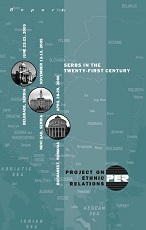Serbs in the Twenty-First Century
Serbs in the Twenty-First Century
Author(s): Steven Burg
Contributor(s): Livia Plaks (Editor)
Subject(s): International relations/trade, Politics of History/Memory
Published by: PER Project on Ethnic Relations
Keywords: Serbian ethnic identity; Serbia and EU;
Summary/Abstract: Southeastern Europe, including Serbia, is at a crucial juncture in its history. Following the crises of the 1990s, the countries of the region are making great efforts to join the European Union, and, in fact, some have made the important step of becoming EU candidates. Serbia’s pivotal location at the center of this region and its historic, political, economic and ethnic ties to its neighbors make the country’s success an essential element for the success of the entire region. Moreover, Serbia’s continued democratic development and its stability are key factors to broader regional stability. For these goals to be achieved, Serbia’s path to European integration must be secured, and the feeling inside Serbia of being “left behind” must be dispelled.
With these considerations in mind, in 2005-2006, the Project on Ethnic Relations (PER) carried out a major project in Serbia under the title “Serbs in the Twenty-First Century.” This project was supported by the Balkan Trust for Democracy of the German Marshall Fund of the United States, the Romanian Government, the Rockefeller Brothers Fund, and the Charles Stewart Mott Foundation. In the first part of this initiative, PER organized a dialogue in Belgrade among Serb political leaders, both from within and outside of Serbia, on issues related to the interplay between identity and politics. During this meeting, participants analyzed the relationships between Serbia and the Serbs and their political representatives who live outside Serbia in states that emerged after the dissolution of Yugoslavia. They also discussed their relations with Serbia as a state, and models of cooperation between their “mother state” and their home countries. PER followed this first meeting with a dialogue in Novi Sad on multiethnicity and citizenship in Serbia, relations between minorities and the Serbian majority, and possibilities for how Serbia can redefine itself as a country of all its citizens. Minority representatives also took part in this dialogue. The last part of the “Serbs in the Twenty-First Century” initiative, held in Bucharest, brought to the table representatives of the Serbian government and parliament, representatives of Serbia’s neighbors, and participants from U.S. and international organizations to discuss the issue of Serbs and their neighbors. This discussion was conceived in the belief that everything that happens in Serbia and to Serbs has an impact on its neighbors, and everything that happens in the neighborhood has an impact on Serbia. Important topics in this discussion were the referendum on independence in Montenegro and the question of Kosovo’s future status, and how these developments will influence Serbia and its stability. Participants also considered how the international community could help Serbia in this difficult and uncertain period.
Series: PER Reports
- Page Count: 48
- Publication Year: 2006
- Language: English
- Content File-PDF

